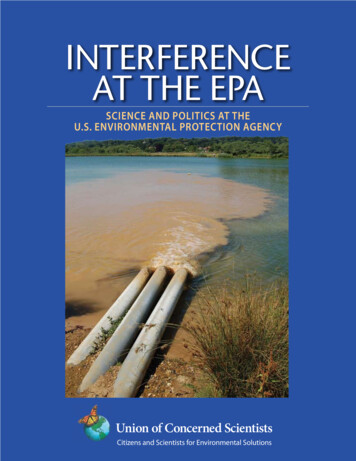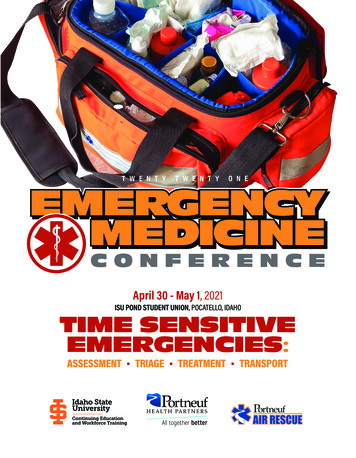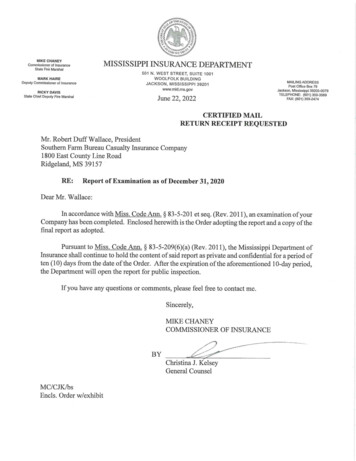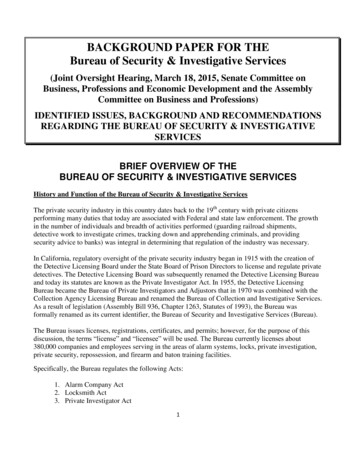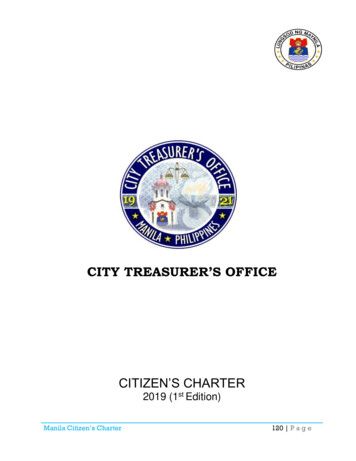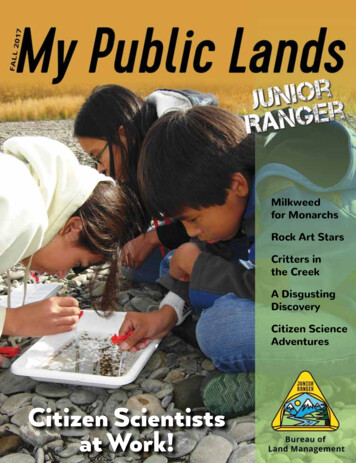
Transcription
Milkweedfor MonarchsRock Art StarsCritters inthe CreekA DisgustingDiscoveryCitizen ScienceAdventuresCitizen Scientistsat Work!
What’sInside2You Can Be aCitizen Scientist4MonitoringMonarchsPublic LandsBLM manages245 MILLIONACRES5Recording AncientRock Art6Find Your CitizenScience Adventure8Life in the Stream10Invasive SpeciesDiscoveredMore than99%of BLM-managedlands are open forrecreation11BLM Junior RangerCertificateInside BackCoverMake a StreamScopeBecome a BLM Junior Ranger!The Junior Ranger programintroduces young adventurers likeyou to the lands and resources of theBureau of Land Management.We invite you to join the adventure!Learn more at blm.gov/education.
Belong to You!Morethan62 MILLIONVISITSeach year to BLM-1managed landsFind Junior Ranger activities at over50 LOCATIONSThe Bureau of Land Management (BLM) is a federal government agency thatcares for public lands. These lands are managed for many different uses andbelong to all Americans.BLM lands provide energy resources, such as coal, oil, and natural gas. Theyprovide habitat for wildlife, food for grazing animals, and timber for people.The lands contain evidence of the past, such as dinosaur bones and plant fossils.Archaeological sites on public lands help us learn about people who lived herelong ago. Each year millions of people explore the big open spaces on these lands.EnergyForestryWild Horses & ltural Resources
You Can Be a Citizen ScientistAre you curious about nature? Do you enjoy outdoor adventures?You can do citizen science while exploring the great outdoors!2Citizen scientists are people who volunteer to collect information,or data, for scientific research. Citizen scientists do not need acollege degree, and they don’t have to be adults. What they doneed is a sense of curiosity about the natural world, and a littletime to spend observing it.Citizen science:scientific research thathappens when ordinarypeople observe the worldaround them and sharethat information withscientists and landmanagers.Kids are natural citizen scientists. Like scientists, they arecurious and ask a lot of questions. They notice things andenjoy investigating and exploring nature. Kids just like you canmake real contributions as citizenscientists. In fact, many already are.Millions of people around the world are doing citizenscience. They are gathering more information, frommore places, than scientists could ever do withouttheir help. Thanks to citizen scientists, ourunderstanding of the natural world isgrowing and growing.Citizen Science onPublic LandsOut on public lands, peopleare collecting data whilehiking, biking, fishing, andjust having fun. Theyexplore wildernesses,historic trails, wild andscenic rivers, nationalmonuments, and otheramazing places, and share theirobservations with land managers. Theirwork helps the BLM protect and preserveAmerica’s public lands for all of us to enjoy!
Are you interested inbecoming a citizen scientist?Fill out the application to see if you ck all that appI am a person.I have a brain.I am curious.ture.I notice things in nalearn.I can share what Intists and publicI want to help scieland managers.(circle):I am interested tulations!You have what it takes to be acitizen scientist!There are many ways for you to getinvolved in citizen science. You canobserve nature in your neighborhood, orsign up for a citizen science event. Youcan visit public lands with your familyand collect data for land managers.Read on to learn about some excitingopportunities for citizen scientists likeyou.Citizen Scientist ID CardOther:Just for fun, make your personalcitizen scientist identification card.Feel free to add a photo or drawingof yourself.Citizen Scientist ID CardName:Areas of Interest:
Monitoring MonarchsEvery fall, monarch butterflies migrate hundreds, even thousands, of miles to southernCalifornia and central Mexico. Along the way, they stop to drink nectar from wildflowers andother flowering plants. Reaching their winter homes, they gather in the trees and form largeclusters, or roosts, to stay warm. They remain in their roosts until spring, whenwarmer weather signals that it’s time to breed. Soon, a new generationof monarchs will make the long trip back to their summer habitats.4For female monarchs to reproduce successfully, they must lay theireggs on milkweed. The caterpillars that hatch will be hungry, and milkweedis the only plant they will eat. Without milkweed, monarchs cannot survive. Butmilkweed and sources of nectar have become scarce, and monarch populations are declining.To increase monarch habitat, BLM scientists collect native milkweed seeds and use them togrow more milkweed. Seeds harvested from the new plants are shared with citizen scientiststo plant in gardens, schoolyards, and parks. In addition, the BLM belongs to the MonarchJoint Venture, a partnership dedicated to monarch conservation. Citizen scientists can helpby planting milkweed and other wildflowers, and by observingmonarch life cycles.Learn how to help bring back thebutterflies at monarchjointventure.org.Find 5 monarch butterflies and9 monarch caterpillars in themilkweed patch. Color thesketch if you wish.
Recording Ancient Rock ArtLong ago, peoplepainted, chipped, andchiseled pictures on rockwalls and boulders. Manyancient rock paintings(pictographs) andcarvings (petroglyphs)are located on publiclands. These rock artsites are evidence of thepast and are consideredcultural treasures. ForNative Americans, rock artcan have both historicaland sacred value.Look at the picturesabove. Which rock artdesigns are painted andwhich are carved? Write“1” for pictograph and“2” for petroglyph.(Answers on page 12)In New Mexico a groupof citizen scientists,known as the RockArt Team, is on amission to create apermanent record ofthe ancient designs.They take photos, makemeasurements, andwrite down the locationsof rock art sites. To avoiddamaging the art, theycarefully follow historic preservation guidelines.Their work helps the BLM protect and preservethese cultural treasures. These citizen scientistsreally are rock art stars!The BLM is required by law to protect culturalresources on public lands. Learn more atblm.gov/programs/cultural-resources.Little Black Canyon Petroglyph Site, Arizona5
Find Your CitizenIn your neighborhood, or on public lands,Party with the stars!On the Grand Canyon’s northern rim is a wild, ruggedarea of more than a million acres. By day, GrandCanyon-Parashant National Monument is a great placefor exploring canyons, plateaus, and mountains. Afterthe sun sets, it’s one of the best places on Earth forexploring the night sky. Sparkling with the light ofcountless stars, our home galaxy looks like a milky river.Most people live in places where they can’t see theMilky Way. Because of light pollution, only the moonand the brightest planets and stars are visible. TheGlobe at Night website provides tools for measuringstar brightness. Using the online app, citizen scientistshave already shared more than 100,000 measurements.Scientists use this data to learn how light pollutionaffects birds, bugs, and other wildlife. Be part of thisproject by visiting globeatnight.org.Explore wild places!With dramatic desert views, tall cliffs, and narrowslot canyons, Crack Canyon is a fun place for familyadventure. There are hiking trails for all skill levels androck art sites hidden in some of the canyons.Crack Canyon is one of hundreds of Wilderness StudyAreas, or WSAs, managed by the BLM. ManagingWSAs is a huge job for the BLM, but specially trainedcitizen scientists are making it easier. Using an appcalled WildSNAP, they report on important wildlifehabitat and historic sites. They take photos of nativeplants and damage to trails. These adventurousvolunteers are helping the BLM keep the “wild” in“wilderness.” Learn more at wildsnap.org.FUnder the Wilderness Act of 1964, the BLM protects morethan 200 federally designated wilderness areas. These wild,unspoiled places are habitat for wildlife and sources of cleanwater and clean air.
Science Adventurehave fun doing citizen science with your family.Find feathered friends!Connect with nature!Celebrate Urban Birds (CUBS) seeks kid citizenscientists, like you, to study birds that live in citiesand towns. Your observations will help scientistsunderstand how birds use city parks and other greenspaces. If you see a nest in a weird place, entera photo in the Funky Nests Contest. Sign up atcelebrateurbanbirds.org.Nature’s Notebook needs citizen scientists to observehow living things adapt to the seasons. Visit thewebsite to select a plant or an animal to observe. Thedata you share will help scientists and land managersand could lead to scientific discovery! Learn more atnaturesnotebook.org.The place to see eagles, falcons, owls, and otherraptors is Morley Nelson Snake River Birds of PreyNational Conservation Area in Idaho. Every year,hundreds of pairs of these meat-eating birds nest onthe canyon walls of the Snake River. Another greatdestination for birdwatching is Jupiter Inlet LighthouseOutstanding Natural Area in Florida. As you hike thetrails or paddle the lagoon, watch for pelicans, egrets,ibis, and other water birds.People of all ages can participate in the Great BackyardBird Count. Learn more at birds.cornell.edu.California’s King Range National Conservation Area isa favorite destination for families. Watch for signs ofspring along the Bear Creek Nature Trail. Share yourobservations with the BLM to help the agency monitorseasonal changes. In autumn, head to the Bizz JohnsonNational Recreation Trail to enjoy the fall colors whilehiking, biking, or horseback riding. Wander back inthe winter with skis or snowshoes to look for animalfootprints in the snow.Plan your next adventure atblm.gov/visit!
Life in theStream8Water WatchJoin citizen scientistsfrom around the globein a worldwide waterwatch. Find out more atmonitorwater.org.A watershedis the land that rain andmelted snow flow across and throughon the way to streams, rivers, wetlands, andlakes. The health of stream water depends on thequality of the watershed. Watersheds also affect thewater people use at home, school, and work.Much of the watershed in the West includes public lands. Oneof the BLM’s many jobs is managing land and water resourcesto protect those watersheds. If a stream or river becomescontaminated, that can harm the fish, the wildlife, and the peoplewho depend on the watershed.Stream SelfieHelp scientists learnmore about the health of ourstreams. Take a picture of astream in your neighborhood,answer a few questions,and share atstreamselfie.org.How healthy are America’s streams? Citizen scientists are helping tofind the answer. Healthy streams attract a wide variety, or diversity, ofliving things. One way to judge the health of a stream is by counting thedifferent kinds, or species, of animals living in the stream.Counting Creek CrittersGive your neighborhood stream a checkup by counting the number of insect- andworm-like critters (stream macroinvertebrates) that live in the water. Use the CreekCritters Data Sheet to identify and record the species you see.Materials: Pan or shallow container for holdingcreek water Net or cup for scooping up water bugs Magnifier (optional) Pencil or pen Ruler (see side of page) Creek Critters Data SheetFind a free app for identifying streammacroinvertebrates at iwla.org/aquabugs.
Creek Critters Data SheetLocation:Weather(circle):Date:sunnyAppearance ofwater (circle):cloudycleardrymuddyStreambedorange or reddishcolor (circle):Odor of watermusky(circle):Sensitive:Needs clean, unpolluted waterTotal sensitive to hotoilycoolfoamycoldmilkyblackrotten eggmetallic(sulphur)chemical(e.g., chlorine)Somewhat sensitive:Can tolerate some pollutionTotal somewhat sensitive:other:other:other:9other:Not sensitive:Tolerant of pollutionTotal not sensitive:Based on your observations, how do you rate the stream’s health?Talk with family and friends about things you can do if you think your stream is unhealthy.
Invasive Species DiscoveredBioblitz:a special eventfor scientists andSitka, Alaskavolunteers to recordJune 2010all the living speciesParticipants in a citizen science bioblitz in Whiting Harbor made a disgustingthey see in andiscovery. Below the water’s surface, massive numbers of a small sea animal seemedarea.to cover everything. Sea squirts were clinging to docks, moorings, boat ramps, androcks. The appearance of the slimy mass earned sea squirts a nickname—rock vomit.10In the waters of North America, sea squirts are a non-native, or invasive, species, andso they have no natural enemies. Sea squirts reproduce quickly, even by cloning. Withoutpredators or disease to control them, they can quickly take over. This was the case in Whiting Harbor,where native shellfish and fish habitat had disappeared under a carpet of slime.The BLM is responsible for managing andprotecting fish habitat in Whiting Harbor. Thediscovery of sea squirts meant BLM scientists had abig problem. So they teamed up with scientists fromother agencies to think of possible solutions, liketreating areas with salt, chlorine, and cement dust.By comparing treated areas to untreated “control”areas, they are finding the most effective way to getrid of sea squirts and prevent them from spreading.Backyard BioblitzSea squirtsclinging toan oysternetYou can do a bioblitz almost anywhere—in the city, ina park, at your school, or in your yard. Any green space,however small, will do. Invite family members and friendsto join in the fun and become bioblitz team members.Draw a simple map of the site. Label the main features, such as trees, logs, stumps, leaf piles, and paths.Spend some time looking around for wildlife. On the map, mark where you find them. A field guide can helpyou identify the species by name. Take pictures or sketch what you see. When you are done, complete thebioblitz log.Bioblitz Log:Bioblitz Site Date/SeasonWeather TemperatureCount or tally the number of species of animals you see for each of the categories listed. If yousaw sparrows, cardinals, and robins, the count for “Birds” would be 3, because you saw threedifferent species.Species Categories:Amphibians Fish MammalsBirds Insects ReptilesOther Total number of species observedYou can contribute your observations to the citizen science databank at iNaturalist.org.
BLM Junior RangerCertificateAs a Bureau of Land Management Junior Ranger,I promise to: Do all I can to help preserve and protect the natural andcultural resources on our public lands. Be aware of how my actions can affect other living thingsand the evidence of our past. Keep learning about our important heritage. Share what I have learned with others.Junior Ranger SignatureDate
12AnswersRecording Ancient Rock Artpictographs 1petroglyphs 2211122221Aravaipa Canyon Wilderness, Arizona
Make a Stream ScopeMaterials: Tall container, such as alarge beverage bottle, milkcarton or jug, or wipescontainer Plastic wrap Rubber bands Duct tape or packing tape ScissorsActivity instructions:1. Cut the bottom off of the container. If you are using a bottle or jug, cut the neck off too. Ask anadult for help if the plastic is difficult to cut.2. Cut a piece of plastic wrap large enough to cover the top of the container and as much of the sidesas possible.3. Place the plastic wrap over the top of the container. Use rubber bands to keep it in place.4. Tape the edges of the plastic wrap securely to thesides of the container to prevent waterfrom entering.Note: The plastic should be a little loose, so itwill curve inward and act like a lens.Test your stream scope by dipping it in asink or bowl of water to make sure itdoesn’t leak. Place a penny or other smallitem in the bowl to see how well the scopeworks. (If it leaks, you will not be able tosee clearly.) Adjust as necessary.When you are satisfied with your design,head down to the stream. Place yourstream scope gently into the water andpeer inside. Do you see any crittersin the creek?
Gold Butte National Monument, NevadaBureau of Land ManagementDivision of Education, Interpretation, and Partnerships1849 C Street, NW, LM 2134Washington, DC 20240(202) 912-7457kids@blm.govThis publication was produced by the BLM Division of Education, Interpretation, and Partnerships.Production services were provided by the BLM National Operations Center, Information andPublishing Services Section.EE2038FBLM/WO/GI-18/001 1115For additional copies, contact:
ancient rock paintings (pictographs) and carvings (petroglyphs) are located on public lands. These rock art sites are evidence of the past and are considered cultural treasures. For Native Americans, rock art can have both historical and sacred value. In New Mexico a group of citizen scientists, known as the Rock Art Team, is on a

